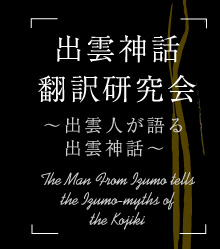大国主神 “O-kuni-nushi-no-kami”
7.少名毘古那神と国作り “Sukuna-biko-na-no-kami and the Establishment of the Land”
Then Ō-kuni-nushi-no-kami was sitting on the cape of Miho1; when he saw a deity on the crest of the waves coming toward him on a heavenly kakami2 boat, dressed in tiny clothing made of himushi insects. Hereat Ō-kuni-nushi-no-kami called out asking it who it was. But it did not reply; and he asked the same question to his deity followers but they all answered, “We don’t know, either.” Then was there a toad, saying, “I suppose Kue-biko must know.” So Ō-kuni-nushi-no-kami called Kue-biko to him and asked the same question, at which Kue-biko answered, “This is Sukuna-biko-na-no-kami, the son of Kami-musubi-no-kami.” Then, therefore, Ō-kuni-nushi-no-kami likewise asked the parent deity, Kami-musubi-no-kami, and the parent deity answered and announced, “This is really one of my children, the one who slipped through my fingers. Therefore you and he, Ashi-hara-shiko-o-no-mikoto, shall be brothers now onward and make and form the land together.” So from then on, O-namuji and Sukuna-biko-na-no-kami, the two deities together, made and formed this land.3 Finishing that, Sukuna-biko-na-no-kami went over to the land of immortal life, Toko-yo-no-kuni. The so-called Kue-biko, who identified Sukuna-biko-na-no-kami is now said to be yamada no sohozu, a scarecrow deity standing in rice fields among the mountains. This deity, who cannot walk, is the god who knows every single thing of things of the world.
At this Ō-kuni-nushi-no-kami said, lamenting himself, “How can I establish and complete this land only by myself? What deity would I be able to cooperate with in establishing and completing this land?” Then, shining over the sea, came a deity up toward him and said, “If you can offer me good worship and service, I can work together with you in completing this land. If you cannot, the land will not be completed and established.” At this Ō-kuni-nushi-no-kami asked, “Well then, in what manner should I worship you?” and the deity’s reply was, “Worship and serve me on the eastern range of the fresh green fence of mountains around Yamato.” This the deity who has its divine seat on the top mount Mimoro.
Notes | 注釈
#1 The cape of Miho is the cape of Jizou-zaki in Miho-no-seki, one of the famous sight-seeing spots in San-in. We can see the names, “Miho-no-ura” or “O-hama” for the present “Miho-no-seki” but not any “Miho-no-seki” in Taihei-ki, a historical epic which is supposed to have been compiled after about 1333, the year of the fall of Kamakura shougunate. The name Miho-no-seki, if we try to estimate the time of its origin, seems to have been used no earlier than toward the end of the Kamakura era, after which seki-sho (official checkpoints for seatraffic) appeared.
#2 In the present day “kakami” is called “gaga-imo”, which is the Japanese name for rough potato, a type of climber plant. Gaga-imo is about 10 cm long and its shape is like a boat (Japanese fune or if compounded,-bune). On the other hand, Sukuna-bikona-no-kami’s clothing is made of skin from Himushi, an archaic or poetic Japanese word for a moth or a butterfly, so this deity had a very tiny body dressed in very tiny clothes and came on the waves in a very tiny boat up to Ō-kuni-nushi-no-kami.
#3 This shows Sukuna-bikona-no-kami exerted his strength powerfully in creating the Izumo Land in spite of his very tiny-built body. In this Japanese mythology, small deities are described to have their own significant duties and not only the big but also the small ones do play the important roles in completing their Land Making. This may mean to show that good cooperation between the big and the small enables them to exert their best and most effective power. Thus Ō-kuni-nushi-no-kami and Sukuna-bikona-no-kami did their Land Making together and we can say that the Land Making of Izumo made rapid progress.
